I wrote this back on 2/20/08 onour local climbing forum. That winter was the first year I climbedwith a pair of Nomics. Not much has changedin the last 5 years that I can tell really. Head lamps have gotten better. Boots marginally so but nothing earth shaking. Clothes have gotten warmer and lighter. But some of this seemed like a real revelation 5 years ago. Umbilicals and leashless toolsare common now. They weren't well received by all 5 years ago. Most of all I am just glad I finally got off the couch again! It hasbeen a fun ride.

Hopefully beginner and intermediate ice climbers and aspiring technical climbers in an alpine environment will find the info and opinions to follow helpful. Nothing new here. Twight and Gadd cover it all much better in their respective books. The two books compliment each other. Buy them. Twight’s “Extreme Alpinism” has the best coverage of the details. His book is the “required read”. Gadd takes up the technical discussion from where Twight ended. I’ve reread both in the last month several times and gleaned other's suggestions for the Internet to try out. Gear choices are constantly being out dated. Good gear makes climbing easier...and safer.
I have little time for the guys who have opinions but have yet to have btdt. So a little back ground, and still enough ego to share an opinion. Back in the late ‘70s and early ‘80s I was fortunate enough to climb a few routes that are still considered worthy accomplishments. In no special order, the 2nd ascent of Slipstream, mid January, in 7hrs with a car to car time of 14 hr. r/t and a walk down the Athabasca. An early one day ascent of Polar Circus with 3 more ascents of the route by 1982. 2nd solo of the Becky route on Edith Cavell taking a direct line up the climb from the car door, 7hrs from lacing up my boots to the summit cross down climbing the East Ridge and back for lunch. A new route on N face of Temple. The 2nd ascent of Super Couloir on Deltaform, in a storm, via the original finish. Other water fall routes like Upper weeping wall (twice), Pilsner, Carlsberg (a couple of times), Takakkaw, Borgeau LF, among many.
So nothing horrendous even by the standards 20 years ago and light years behind stuff being done today. But climbs many guys are still aspiring to as they gain confidence and skilltoday.
By ’85 I wasn’t really climbing much ice. I was doing a lot of trad climbing up to .12b. Sport routes held little interest for me. I found other hobbies and work too committing. Climbing began to take a back seat after living that life style for 20 years. At some point I realized I wasn’t climbing at all. Not climbing rock, ice or mountains! That went on for too many years.
Then in Jan '08, a full 20 years later, I'm was dragged into Canada for ice, cold turkey, off the couch.
Past 50 years old (trust me that sounds older to me than it does to you) I at least have the means to generally buy what ever I wanted for gear. Yes, time will even solve the major problem of most every dirt bag climber

, even this one.
I bought into the Schoeller revolution. I had a pair of stretch European salopettesfrom the '80s that I last guided and heli skied in so I knew that was the right track. Bought the Arcteryx soft shell MX top and bottoms in several weights. More on that later. Also bought a new set of tools, a buddy gave me a set of newer crampons (more later on the subject as well) and off I went. Fat, dumb and if not happy at least excited to be climbing ice again.
Avalanche conditions in Canada this winter could hardly be worse. We started off on Louise. It is cold, I mean –30C cold. I have fewer clothes on than I have ever climbed in. I have the lightest gloves on I have ever used for winter ice and the most flexible ankles in lwt boots that I could image. I hate that damn pillar no matter how many times I have climbed it (over a dozen). But with this gear Louise’s pillar is the easiest I ever seen it.
The next 14 days of ice and mixed climbing were a real education thanks to my many old and new partners and mentors willing to put up with me.
OK, here are “MY” opinions. Not every one will share them. Remember everyone has one and you too are welcome to yours here.
After a full two weeks of climbing in everything from a pissing down NW rain, a snow storm dropping 6” in an hr, and down to –30C with hallowing wind I can say hard shell clothing is obsolete for technical climbing short of some really horrendous conditions I can’t actually image being out in. And with 7 trips to the Alaska Range I can image some pretty shitting conditions. My suggestion? Buy the lightest weight, most stretchy garments and learn to climb in what Twight calls his “action suit”. If it aint got a hood that will go over a helmet easily don’t buy it.
Only caveat to that is your base layer. You might want to think about putting some wool next to your body and a light synthetic layer/s over it. Add hoods that will go under and over your a helmet. The “R” series Patagonia hoody or the really simple Nike hoody (which I like even better for cold weather) works well. Thumb loops on the sleeves have been around 30 years at least and are really cool features in cold weather BTW.
Gloves?
Always take a few pair in the pack or pocket. At least one pair specifically for when it gets really cold from a change in weather, your exhaustion or a long, cold belay. Depending on the climb I will use a thick glove or a mitten. You'll want to error on the side of caution when choosing the “big” glove. You don’t want to pull out the ‘big ‘uns” and find you still are not warm enough and screwed. Heat packs are a good option to carry as well. Remember hydration and calorie intake are as important or more so than big gloves and a belay jacket. I’m using a really light glove made by Mountain Hardware, the “Epic”. REI has the same glove just a bit less durable. Go light…you’ll be amazed. Carry spares to stay dry as required. I’ve only pulled my “big” gloves once this season. But I have gone through up to three sets of the lighter gloves to keep my hands dry. The light gloves aren’t very durable. Leather rappel gloves are a good idea and work well on some hard mixed depending on temps.
Hats? Headbands under the helmet regulate heat better with helmet and layers of hoods than a hat will. The band will also add to your warmth if pulled down to your neckline and nothing to drop. I no longer carry a hat. But I pull on or off any one the layers of hoods over my helmet at belays or while climbing. Try that with a hat while climbing a hard pitch!
Leashes? This ought to get some comments. You’d have to be an a complete, uneducated knob to climb with a leash on a modern tool. No ifs on that one. The human form and the tools are finally a synergistic extension of the mind while climbing. Ice climbing at any level is simpler, warmer and EASIER leashless. Hard to believe but that will make even hard grade 5 ice more secure.
Several of my buddies disagree some with my conclusions and they know the differences, tells me I only came to my conclusions because I haven't climbed ice in 10 years so the change was easier for me. Remember I am an old guy, and trust me if leashless wasn't faster, easier and warmer I would NOT be doing it. I don't give a shit about appearances, I just want to get up the climb as fast with the least amount of effort as possible. Leashless is a big part of both.
Umbilicals? For what the mind can’t control? If you are less than 70m from the ground climb leashless and forget the umbilical. If you are higher than 70m put an umbilical on the damn thing. Nothing worse than sending your 2nd your spare toolor climbing a hard pitch with one tool or being forced to jug or worst of all rap. Trust me, an umbilical is better than wrecking a good relationship or worse yet an expensive trip.
I now flatly refuse to climb with anyone that hasn’t got their tool tied on to something. My time and experience is just too valuable to me to waste it on a tool getting knocked off at a belay or dropped for what ever reason, including me knocking it off by accident. How about leaving a tool at a v thread on the rap. Thathas happened more than once to even some very experienced climbers. Umbilicals use to be seen as a sign of incompetence. Now I see there lack as a sign of ignorance on anything past a short sport route. Before you start rolling your eyes...take a look at what the "big boys" are doing these days on alpine routes. Makes me think that passing 4 tools around between 3 guys (after dropping two leashless tools) on one of the bigger/harder alpine routes made a broad impression.
I've already had to rap 2000' after a partner dropped a tool on a hard alpine route in perfect weather. Lost a perfectly good alpine rack as well in that experience. Not excited to repeat that costly adventure.
Boots? Fruit boot technology is catching up to the Mtn. boot technology. You’ll climb different in them but you’ll also climb better. Ice becomes more like rock climbing in the soft ankle boots. Haven’t found one I want to send 1000m of hard 55% alpine ice in but it is entertaining trying to figure out how to rest the calves with French technique at every opportunity. More time in soft boots will likely encourage me to take them on endurance alpine ice.
Now we have both warm boots and soft ankle boots that have a rigid sole for even my size 12 feet. They can be amazing. Check out the usual suspects to see what fits you. I like the Batura for cold stuff close to the road (they are hard to dry out) and the Spantik for anything over a day out. There are much lighter boots I could be climbing in. We’ve only just seen the beginning to the newest boot technology. In the future look for a dbl. layered fruit boot that is warm enough for Denali which you’ll actually want to use for that M10 at your local crag.
Tools/crampons? Any of the newest tools from Grivel, BD or Petzel works better that anything from even a few years ago. BD seems to have the biggest issue breaking picks. Grivel has the solid reputation of bomb proof and no one can question how well they climb. Petzl stuff is not cheap but climbs very well and is very durable as well. The other brands at the moment are simply "hangers on". If you aspire to climb hard forget anything that doesn’t have good leashless support.
Mono points? If you want to do hard mixed it is the only game in town. Not impossible to climb hard with dual front points but why bother with the extra effort? Same with fruit boots. You don’t intentionally climb hard rock in big boots. Why would you do hard mixed in them? You need to take the time to fit any crampon perfectly. Then take the first few days you climb in them and fine tune the fit. Dropping a tool sucks. Dropping a crampon can easily get you DEAD.
Ice screws? If you aren’t currently climbing with the newest generation of Grivel screws, specifically the Helix, youare wasting energy. I’ve tried EVERY new screw design currently on the market, in almost every snow and ice condition you can think of. With all due respectand with no hype, no bs, there is no other manufacture even close to Grivel's current production. The Grivel screws are as revolutionary to ice climbing as Jardine's Friends were 30 years ago. Big statement I know. But placing good gear, easily, where you want it instead of were you could makes climbing much, much easier and a lot safer.
Add some quick draws, and a few slings made to absorb the load and pretty much set. The lwt wire gate biners hold everything together and don't easily freeze. Plate or “guide” belay devices that will allow you to belay off the anchors with a documented catch on a 400’ fall (yes FOUR hundred feet) will take the rest of the load.
My rack? Helix mostly and only one 22mm screws. With the newest test results I have switched to a lot of 13cm shorties. The Helix stack on a carbiner just fine. Buy the big plastic racking biners from BD or Petzel. They work even better for racking screws and axes.
Headlamps? I spent the last week intentionally climbing many of the 30 or so 60m pitches in the dead of night with a headlamp. I have the high tech rechargeable BD and a cheap 3 AAA Petzel. I prefer to climb with the Petzel as the softer light is easier on my eyes. The BD on the bright halogen setting was good for scoping out the ropes on free hanging 50m raps and complicated route finding. But the Petzel was tiny to carry (unnoticed) and more than enough to get down anything and good enough to get me up anything I can climb.
I am leading at the same level of difficulty on ice now, as I was 25 years ago. You have no idea how unrealistic that really should be. All the while with less effort, while being safer. The main reason, the Grivel Helix. The rest of the stuff mentioned just adds to a more enjoyable and fun experience. Gear will always change over time so stay up on it if you want to keep up.
Spend your money wisely. Thirty year old designs got me up some decent climbs back in the day. The new stuff, if you buy wisely, makes those same climbs much, much easier. That only makes the next level of difficulty much easier to reach. Stay safe and hopefully I’ll see ya out there! I'm the old guy with white hair, and funny tweetie bird boots, stop by and say "hi".
Edited by Dane (02/20/08 6:34 PM)Interesting comments on the original thread:http://cascadeclimbers.com/forum/ubbthreads.php/topics/774878/
Happy holidays to all! And thanks for reading Cold Thistle..
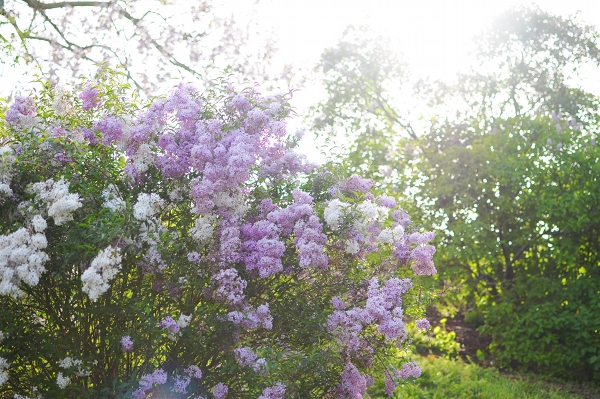 "Lilac Sunday" at the Arnold Arboretum in Boston is an annual celebration of their extensive collection of lilac plants. The lilac is one of my favourite flowers. I find the soft colour beautiful, and the smell intoxicating.
"Lilac Sunday" at the Arnold Arboretum in Boston is an annual celebration of their extensive collection of lilac plants. The lilac is one of my favourite flowers. I find the soft colour beautiful, and the smell intoxicating. I had never been to a flower festival before and did not know what to expect. The Arboretum's "lilac collection" is basically a small hill covered with dozens of lilac plants of every variety imaginable.
I had never been to a flower festival before and did not know what to expect. The Arboretum's "lilac collection" is basically a small hill covered with dozens of lilac plants of every variety imaginable.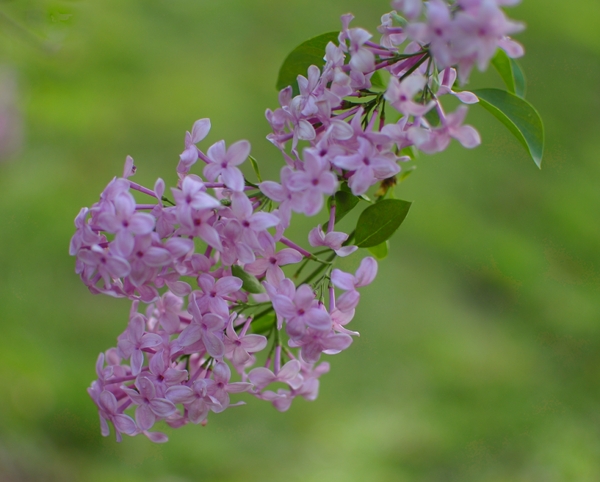 The lilacs' colours included everything from classic pale purple, to white, to ink-blue, to cherry-blossom pink.
The lilacs' colours included everything from classic pale purple, to white, to ink-blue, to cherry-blossom pink. The form of the flowers can vary quite a bit as well - from sparse, crisply outlined petals to fluffy, soft clusters.
The form of the flowers can vary quite a bit as well - from sparse, crisply outlined petals to fluffy, soft clusters.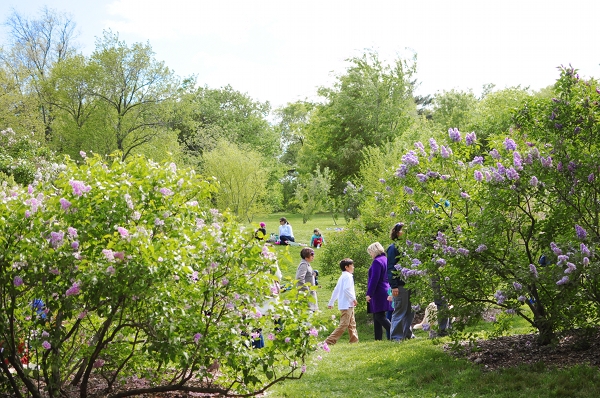 Hundreds of people at a time wandered up and down the hill to pay homage to the lilacs - smelling them, photographing them, having picnics beneath them.
Hundreds of people at a time wandered up and down the hill to pay homage to the lilacs - smelling them, photographing them, having picnics beneath them.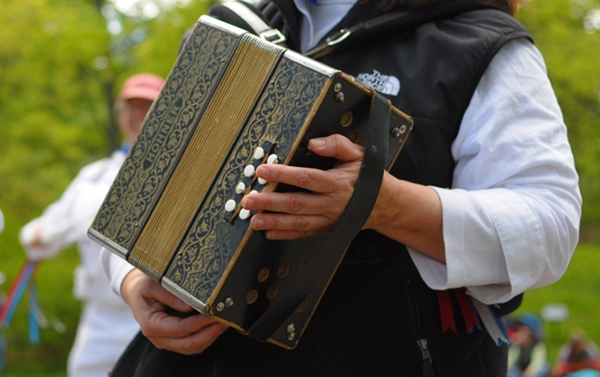 There were also musical and dance performances from several local folk groups.
There were also musical and dance performances from several local folk groups. The festival was so well-attended, that there were probably more people than lilacs - but we did find a spot on the grass nearby.
The festival was so well-attended, that there were probably more people than lilacs - but we did find a spot on the grass nearby. Did I mention I love lilacs? It was blissful to see so many in one place.
Did I mention I love lilacs? It was blissful to see so many in one place. The Roadsters were happy as well, especially as they finally got to cycle along Boston's Emerald Necklace all the way to the Arboretum.
The Roadsters were happy as well, especially as they finally got to cycle along Boston's Emerald Necklace all the way to the Arboretum. The Emerald Necklace is a series of green spaces throughout greater Boston, connected by routes that are meant to be walkable and cycle-able. It includes the Back Bay Fens, the Jamaica Pond, the Riverway, and other small parklands. The project was designed by Frederick Law Olmsted in the 1800's and is fascinating to read about, especially if you are interested in the history of urban planning and park design.
The Emerald Necklace is a series of green spaces throughout greater Boston, connected by routes that are meant to be walkable and cycle-able. It includes the Back Bay Fens, the Jamaica Pond, the Riverway, and other small parklands. The project was designed by Frederick Law Olmsted in the 1800's and is fascinating to read about, especially if you are interested in the history of urban planning and park design.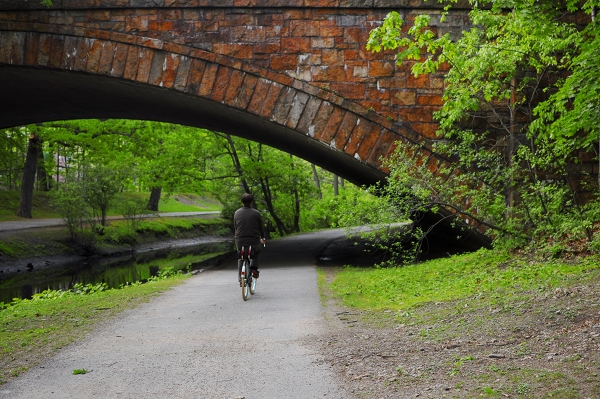 We had wanted to cycle along the entire Necklace for a while, but never had any cause to go in that direction of Boston until now.
We had wanted to cycle along the entire Necklace for a while, but never had any cause to go in that direction of Boston until now. As an urban green sanctuary, the Emerald Necklace is heavenly, with its lush vegetation and delicate bodies of water. As a cycling route... Well, it's frustrating. Throughout much of it, the trails are frequently interrupted by intersections and the crossings range from awkward to dangerous. Motor vehicles just do not yield - not even slowing down as bikes or pedestrians attempt to cross. Even on those intersections where there are lights, the same happens with cars turning: they do not even pause, let alone yield to pedestrians or bicycles.
As an urban green sanctuary, the Emerald Necklace is heavenly, with its lush vegetation and delicate bodies of water. As a cycling route... Well, it's frustrating. Throughout much of it, the trails are frequently interrupted by intersections and the crossings range from awkward to dangerous. Motor vehicles just do not yield - not even slowing down as bikes or pedestrians attempt to cross. Even on those intersections where there are lights, the same happens with cars turning: they do not even pause, let alone yield to pedestrians or bicycles. An additional issue, is that unless you already know how to navigate the Necklace, it is difficult to find your way from one cluster of green to another; there are no signs or markings. We had a map from the Emerald Necklace Concervancy and still had trouble navigating.
An additional issue, is that unless you already know how to navigate the Necklace, it is difficult to find your way from one cluster of green to another; there are no signs or markings. We had a map from the Emerald Necklace Concervancy and still had trouble navigating. On the way back finding our way got a bit easier and we even discovered some secluded dirt paths that the Roadsters liked better than the paved trails.
On the way back finding our way got a bit easier and we even discovered some secluded dirt paths that the Roadsters liked better than the paved trails.









 William Hale Brubaker with his son Gene who was only six days old, according to the writing on the edge of the picture. If so, it would be August 24, 1925. The little girl is Phyllis Phend.
William Hale Brubaker with his son Gene who was only six days old, according to the writing on the edge of the picture. If so, it would be August 24, 1925. The little girl is Phyllis Phend.  Four Generations - sort of - The baby, Gene Brubaker, is being held by his great grandfather William P. Wise. Then it's William's daughter, Maude Wise Brubaker and her son William Hale Brubaker. Not dated, probably 1925-26.
Four Generations - sort of - The baby, Gene Brubaker, is being held by his great grandfather William P. Wise. Then it's William's daughter, Maude Wise Brubaker and her son William Hale Brubaker. Not dated, probably 1925-26.  William Brubaker Family. Fern, Gene, Bill, Glea, and Mary Lee. Not dated, probably 1937-38.
William Brubaker Family. Fern, Gene, Bill, Glea, and Mary Lee. Not dated, probably 1937-38.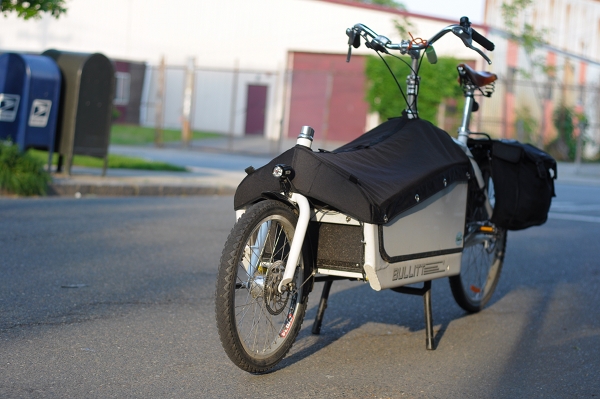 Sometimes Somerville really is a village. On my way home last Friday, I discovered the Co-Habitant, Somervillain and Brian P. engaged in what appeared to be an impromptu bike-testing party, after having crossed paths on their way home from work. The many other cyclists who rode by craned their necks with interest, because of course none of these were "normal" bicycles. Somervillain had his Bike Friday tandem, which he was riding alone. The Co-Habitant had his Pashley. And Brian P. had his Bullitt cargo bike. My own arrival on the swan-frame Pilen complemented the scene nicely.The sun was setting over the Peter Forg Manufacturing Co., bathing the street in that magical golden light. I had wanted to try Brian's cargo bike, and now was my chance.
Sometimes Somerville really is a village. On my way home last Friday, I discovered the Co-Habitant, Somervillain and Brian P. engaged in what appeared to be an impromptu bike-testing party, after having crossed paths on their way home from work. The many other cyclists who rode by craned their necks with interest, because of course none of these were "normal" bicycles. Somervillain had his Bike Friday tandem, which he was riding alone. The Co-Habitant had his Pashley. And Brian P. had his Bullitt cargo bike. My own arrival on the swan-frame Pilen complemented the scene nicely.The sun was setting over the Peter Forg Manufacturing Co., bathing the street in that magical golden light. I had wanted to try Brian's cargo bike, and now was my chance. The bike is a Bullitt "Milk Plus" model, made by Larry vs Harry. It is a Danish cargo bike, based on a traditional "long john" design - similar to a Dutch bakfiets, but with a longer and narrower cargo platform. Larry vs Harry market the Bullit as being fast and sporty in comparison to other cargo bikes. The bike is 245cm (96.5") long, 45cm (18.5") wide, and it weighs 24kg (53lb) unloaded. It has a 20" front wheel and a 26" rear wheel. Detailed geometry specs and blueprints are available here.
The bike is a Bullitt "Milk Plus" model, made by Larry vs Harry. It is a Danish cargo bike, based on a traditional "long john" design - similar to a Dutch bakfiets, but with a longer and narrower cargo platform. Larry vs Harry market the Bullit as being fast and sporty in comparison to other cargo bikes. The bike is 245cm (96.5") long, 45cm (18.5") wide, and it weighs 24kg (53lb) unloaded. It has a 20" front wheel and a 26" rear wheel. Detailed geometry specs and blueprints are available here.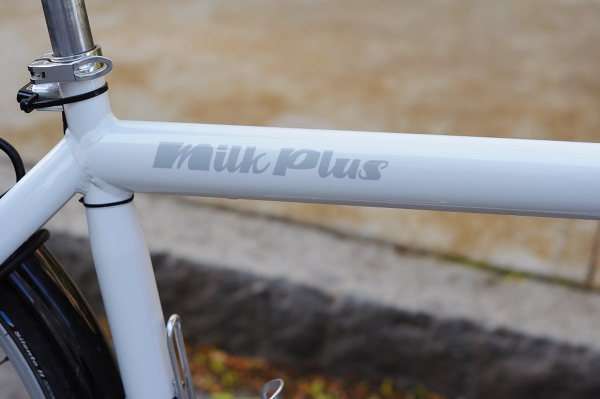 The frame is heavy-duty welded aluminum.
The frame is heavy-duty welded aluminum. The frame is described byBullittownersas extremely stiff.I like the part where the main tube branches out to form the platform - there is something visually appealing about this junction.
The frame is described byBullittownersas extremely stiff.I like the part where the main tube branches out to form the platform - there is something visually appealing about this junction. The (optional) cargo box is plywood. It can be used to carry cargo or passengers and comes with a water-resistant cover.
The (optional) cargo box is plywood. It can be used to carry cargo or passengers and comes with a water-resistant cover. The bike is equipped with disc brakes.
The bike is equipped with disc brakes. And an 8-speed IGH drivetrain. See here for complete specs.
And an 8-speed IGH drivetrain. See here for complete specs. The wide double kickstand keeps the bike unquestionably sturdy and is easy to activate.
The wide double kickstand keeps the bike unquestionably sturdy and is easy to activate. Brian bought this bicycle from Splendid Cycles in Portland, OR, and they installed a dynamo hub with the Supernova E3 headlight and tail light.
Brian bought this bicycle from Splendid Cycles in Portland, OR, and they installed a dynamo hub with the Supernova E3 headlight and tail light. He also replaced the stock racing-style saddle with a Brook Flyer, and he says that that the sprung saddle works well with the stiffness of the frame.
He also replaced the stock racing-style saddle with a Brook Flyer, and he says that that the sprung saddle works well with the stiffness of the frame.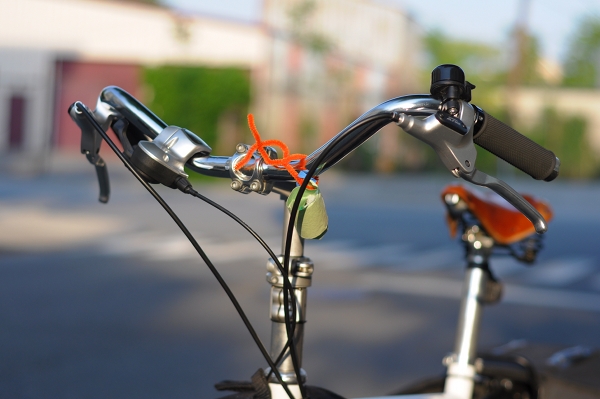 He replaced the stock mountain bike-style handlebars with North Roads,
He replaced the stock mountain bike-style handlebars with North Roads, and added a modified Civia rack from Calhoun Cycle with a set of Dutch panniers.
and added a modified Civia rack from Calhoun Cycle with a set of Dutch panniers. I found the overall look of the modified Milk Plus Bullitttextremely attractive and was looking forward to trying it. It felt well-balanced as I was walking it, which gave me hope.
I found the overall look of the modified Milk Plus Bullitttextremely attractive and was looking forward to trying it. It felt well-balanced as I was walking it, which gave me hope. The saddle is quick release and smooth to operate; I was able to adjust the saddle height myself.
The saddle is quick release and smooth to operate; I was able to adjust the saddle height myself. The stem is also quick release, making it possible for different riders to adjust handlebar height to their tastes.
The stem is also quick release, making it possible for different riders to adjust handlebar height to their tastes. I was able to step over the Bullitt's top tube while wearing a skirt without having to swing my leg around the back; the standover height is similar to that of a large mixte. I was comfortable and ready to ride the bike... which, unfortunately, was not so easy! The main problem is that the Bullitt needs to gain momentum in order to become stable. When just starting or going slowly, the long front end fishtails wildly and the bike is difficult to control.
I was able to step over the Bullitt's top tube while wearing a skirt without having to swing my leg around the back; the standover height is similar to that of a large mixte. I was comfortable and ready to ride the bike... which, unfortunately, was not so easy! The main problem is that the Bullitt needs to gain momentum in order to become stable. When just starting or going slowly, the long front end fishtails wildly and the bike is difficult to control.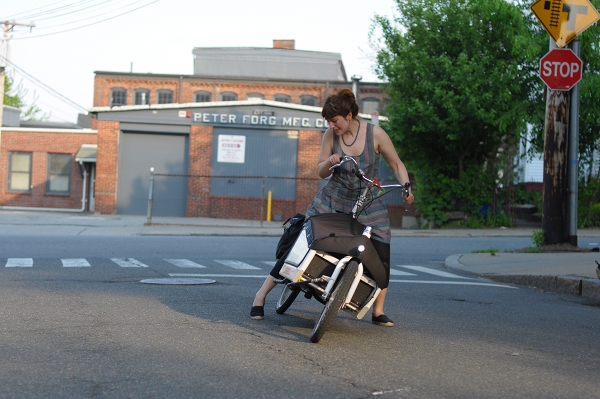 After a few shaky starts, I did manage to ride the Bullitt down the street and pick up some speed, only to falter when attempting to come to a stop. Luckily, the bike was easy to hold up once it started to fall over to the side, so I did not outright crash it into the ground. Not wanting to damage somebody else's shiny bicycle, I did not make further attempts. Not pictured here, but Somervillain tried the Bullitt as well with similar results- false starts, then finally getting it going, then dumping it when attempting to stop at the end of the street. There is a learning curve.
After a few shaky starts, I did manage to ride the Bullitt down the street and pick up some speed, only to falter when attempting to come to a stop. Luckily, the bike was easy to hold up once it started to fall over to the side, so I did not outright crash it into the ground. Not wanting to damage somebody else's shiny bicycle, I did not make further attempts. Not pictured here, but Somervillain tried the Bullitt as well with similar results- false starts, then finally getting it going, then dumping it when attempting to stop at the end of the street. There is a learning curve. I understand the concept of having to get the bike up to speed in order to achieve stability. But unless I am missing something, this seems at odds with using it in stop-and-go traffic - which is what I thought cargo bikes are designed for... In any case, some riders may find operating the Bullitt more intuitive than others.
I understand the concept of having to get the bike up to speed in order to achieve stability. But unless I am missing something, this seems at odds with using it in stop-and-go traffic - which is what I thought cargo bikes are designed for... In any case, some riders may find operating the Bullitt more intuitive than others. The Co-Habitant pretty much was able to ride it, though he described the same fishtailing sensation and said that he'd need a lot of practice to feel comfortable with it in traffic.
The Co-Habitant pretty much was able to ride it, though he described the same fishtailing sensation and said that he'd need a lot of practice to feel comfortable with it in traffic.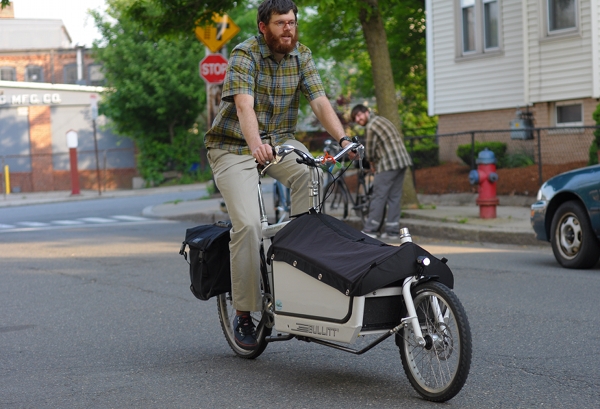 Brian handles the bike like a pro, making it look extremely easy. He reports having been able to ride it pretty much on the day it was assembled - sticking to local streets initially, then venturing into heavier traffic.
Brian handles the bike like a pro, making it look extremely easy. He reports having been able to ride it pretty much on the day it was assembled - sticking to local streets initially, then venturing into heavier traffic. Looking at these pictures, it occurs to me that perhaps people with beards take to the Bullittfaster than people without. Based on our very scientific sample size of n=4 at least, that seems to be the case.
Looking at these pictures, it occurs to me that perhaps people with beards take to the Bullittfaster than people without. Based on our very scientific sample size of n=4 at least, that seems to be the case. At this point, Brian has had the Bullitt for just over 2 months and enjoys it tremendously. It is indeed supposed to be faster and more maneuverable than other cargo bikes, once you get the hang of the handling. Brian lives atop of an insane hill that I would hate to tackle every day even on a roadbike. He finds the Bullittmanageable when cycling up it. Typical commuting speed is about 10mph, or faster with no cargo. Normally, Brian uses the Bullitto pick up his son from daycare and for groceries. He has also done a camping trip on it once, which he will soon describe on his website. When I asked Brian for critical feedback, he replied that the size made the bikeunwieldy to walk - for example, when strolling with someone else on the sidewalk. There is also no good way to secure valuable items on the bike, making multi-trip shopping difficult. These issues are of course common to all cargo bikes.
At this point, Brian has had the Bullitt for just over 2 months and enjoys it tremendously. It is indeed supposed to be faster and more maneuverable than other cargo bikes, once you get the hang of the handling. Brian lives atop of an insane hill that I would hate to tackle every day even on a roadbike. He finds the Bullittmanageable when cycling up it. Typical commuting speed is about 10mph, or faster with no cargo. Normally, Brian uses the Bullitto pick up his son from daycare and for groceries. He has also done a camping trip on it once, which he will soon describe on his website. When I asked Brian for critical feedback, he replied that the size made the bikeunwieldy to walk - for example, when strolling with someone else on the sidewalk. There is also no good way to secure valuable items on the bike, making multi-trip shopping difficult. These issues are of course common to all cargo bikes. The Bullitt Milk Plus with Brian's modifications is dashingly handsome, and just the right size for the kind of cargo we'd need to carry. If I could ride it, I'd be seriously fantasising about it. But while I can see myself quickly getting used to the Christiania trike I tried earlier, realistically speaking I cannot imagine feeling comfortable enough with the Bullittto ride it in traffic. The slow-speed handling is just too quirky for me.Reactions to theBullittseem to greatly depend on individual bike handling skills and preferences.For those who can handle it, the Bullitt is a unique cargo bike option in the combination of speed, agility and load capacity it offers. But I would strongly recommend test riding this bike before buying.
The Bullitt Milk Plus with Brian's modifications is dashingly handsome, and just the right size for the kind of cargo we'd need to carry. If I could ride it, I'd be seriously fantasising about it. But while I can see myself quickly getting used to the Christiania trike I tried earlier, realistically speaking I cannot imagine feeling comfortable enough with the Bullittto ride it in traffic. The slow-speed handling is just too quirky for me.Reactions to theBullittseem to greatly depend on individual bike handling skills and preferences.For those who can handle it, the Bullitt is a unique cargo bike option in the combination of speed, agility and load capacity it offers. But I would strongly recommend test riding this bike before buying.